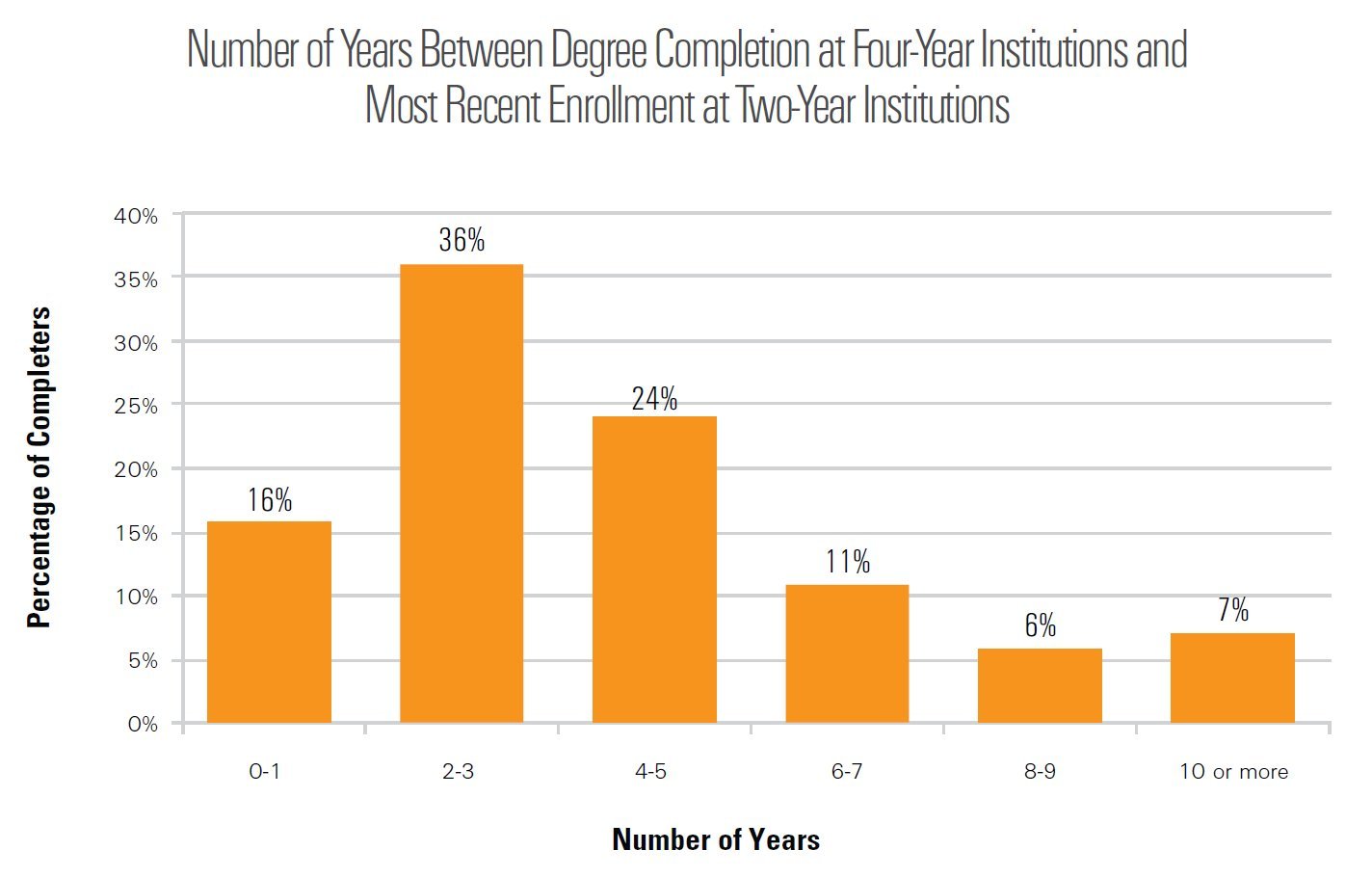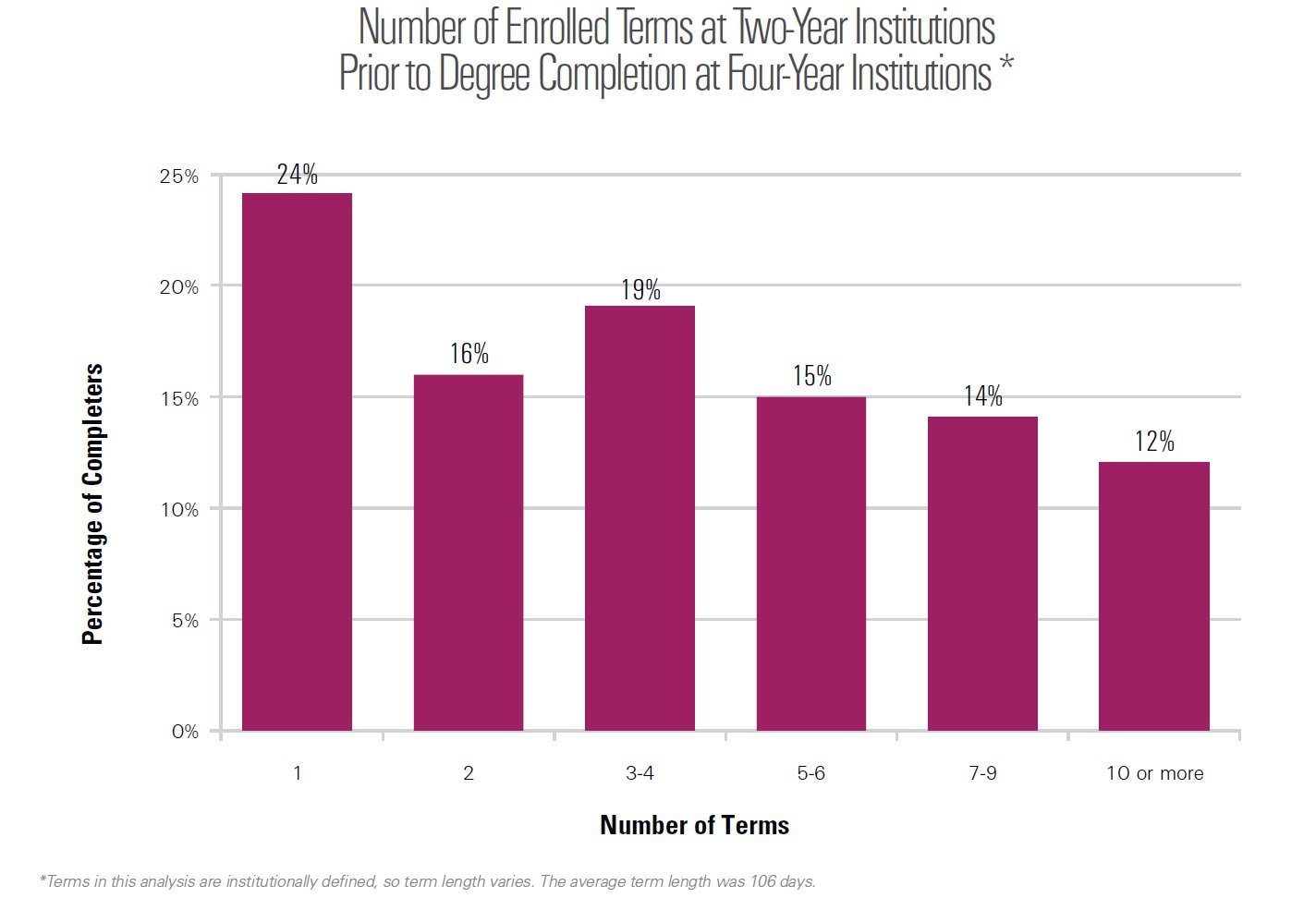You have /5 articles left.
Sign up for a free account or log in.
The notion that community colleges are key to putting students on a path to a four-year degree is not a new one; large numbers of Americans begin their postsecondary studies at two-year colleges, and transfer is one of the institutions' traditional functions. But new data from the National Student Clearinghouse show just how prevalent a role two-year institutions play in providing an educational foundation for those who go on to get bachelor's degrees.
The study -- one of a series on student mobility that the clearinghouse has begun producing to capitalize on the unique data it collects as a repository of student-level information from more than 3,000 colleges -- reveals that 45 percent of all students who finished a four-year degree in 2010-11 had previously enrolled at a two-year college.
Of those students, 24 percent had been enrolled at the two-year institution for just one term, 16 percent for two terms, and 19 percent for three or four terms. But a full 12 percent were enrolled for at least 10 terms, suggesting that even students who spend a significant length of time at a community college might eventually go on to a four-year college.
The data also show that while some of those students take their time finishing degrees upon transferring to four-year institutions, more than half of them earn their bachelor's degrees within three years. Of the 45 percent of four-year-degree completers in 2010-11 who had studied at a community college, 16 percent earned their bachelor's degree within one year of enrolling at the four-year institution, and 36 percent had earned a degree within three years of enrolling. (Twenty-four percent earned degrees within 4 or 5 years, 11 percent within 6 or 7 years, and 7 percent in 10 or more years.)

There is large variation among states in the rates at which four-year-degree holders had prepared at least in part at community colleges. As seen in the table below, one-time community college students made up more than half of the four-year-degree recipients in 13 states -- and more than three-quarters of such students in Texas.
Percentage of Four-Year-Degree Recipients With Community College Backgrounds, by State
| State |
2010-11 Degree Completers at 4-Year Institutions |
Degree Completers at 4-Year Institutions Who Previously Enrolled at 2-Year Institutions |
% of Degree Completers at 4-Year Institutions Who Previously Enrolled at 2-Year Institutions |
| Texas | 148,980 | 116,776 | 78% |
| Wyoming | 2,404 | 1,709 | 71% |
| California | 237,780 | 154,717 | 65% |
| Kansas | 22,458 | 14,651 | 65% |
| Oregon | 26,870 | 16,604 | 62% |
| Mississippi | 18,637 | 11,213 | 60% |
| Oklahoma | 26,215 | 15,164 | 58% |
| Nebraska | 19,343 | 11,034 | 57% |
| Iowa | 27,090 | 15,281 | 56% |
| Missouri | 62,119 | 34,870 | 56% |
| Florida | 112,371 | 61,644 | 55% |
| Illinois | 109,734 | 59,138 | 54% |
| Arizona | 142,973 | 73,869 | 52% |
| Alabama | 37,631 | 18,158 | 48% |
| Arkansas | 19,353 | 9,115 | 47% |
| New Mexico | 10,459 | 4,888 | 47% |
| Tennessee | 40,736 | 18,410 | 45% |
| Virginia | 69,969 | 31,239 | 45% |
| South Carolina | 30,628 | 13,401 | 44% |
| Kentucky | 30,882 | 13,355 | 43% |
| Utah | 36,533 | 15,618 | 43% |
| Colorado | 34,471 | 14,577 | 42% |
| Michigan | 85,222 | 35,902 | 42% |
| Washington | 48,058 | 19,973 | 42% |
| Maryland | 39,733 | 15,949 | 40% |
| Nevada | 11,628 | 4,644 | 40% |
| Hawaii | 6,937 | 2,727 | 39% |
| North Carolina | 65,366 | 25,457 | 39% |
| Minnesota | 57,016 | 21,501 | 38% |
| New Jersey | 52,003 | 19,750 | 38% |
| Louisiana | 30,520 | 10,557 | 35% |
| Wisconsin | 45,871 | 16,207 | 35% |
| Indiana | 69,144 | 23,620 | 34% |
| North Dakota | 8,253 | 2,807 | 34% |
| New York | 202,842 | 67,883 | 33% |
| Idaho | 12,962 | 3,991 | 31% |
| Ohio | 93,543 | 28,893 | 31% |
| West Virginia | 14,677 | 4,593 | 31% |
| Montana | 6,369 | 1,887 | 30% |
| Pennsylvania | 126,093 | 37,375 | 30% |
| Vermont | 9,143 | 2,754 | 30% |
| Connecticut | 27,392 | 7,894 | 29% |
| Georgia | 57,717 | 17,002 | 29% |
| District of Columbia | 23,853 | 6,608 | 28% |
| Rhode Island | 16,645 | 4,608 | 28% |
| South Dakota | 6,834 | 1,699 | 25% |
| Massachusetts | 83,975 | 19,215 | 23% |
| Maine | 9,460 | 2,191 | 23% |
| Delaware | 8,844 | 1,935 | 22% |
| New Hampshire | 14,127 | 3,041 | 22% |
| Alaska | 3,733 | 718 | 19% |
| Totals | 2,505,596 | 1,136,812 | 45% |






